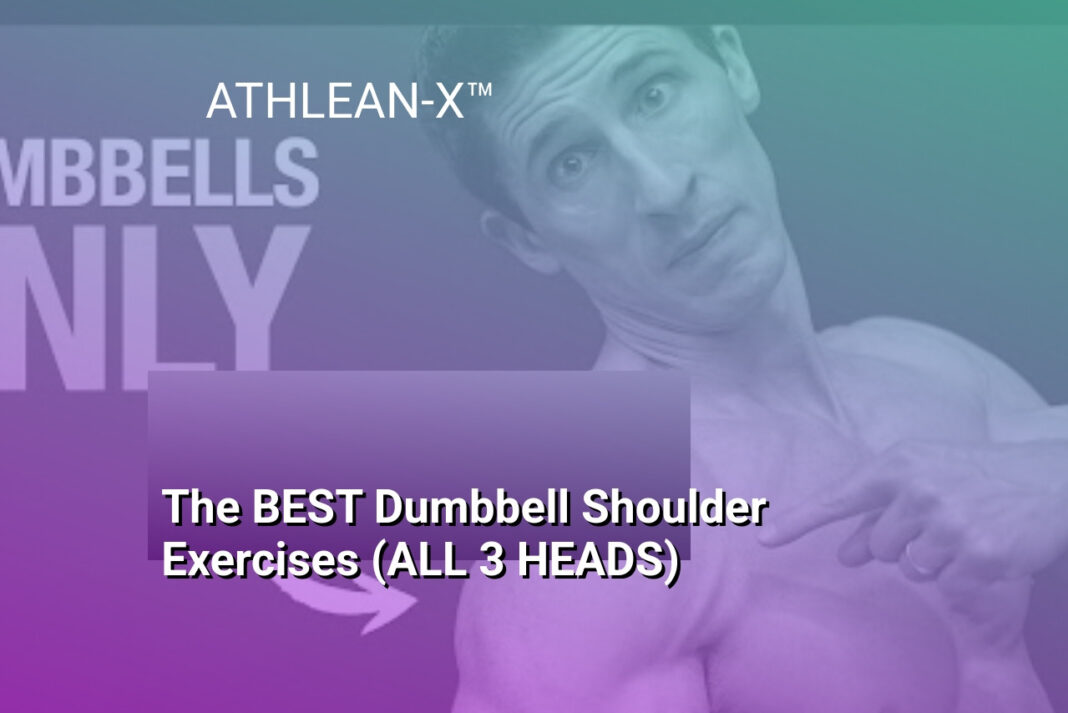The Bottom Line:
- I discovered innovative dumbbell strength training techniques that enhance muscle development and biomechanical efficiency through strategic overhead press variations and explosive movements.
- By incorporating unique hypertrophy methods like cheat lateral raises and one-and-a-half repetitions, I learned how to maximize muscle tension and growth potential.
- Metabolic training techniques such as mechanical drop sets and multi-planar movements offer dynamic ways to challenge muscle endurance and maintain workout intensity.
- Stretch-driven hypertrophy and targeted shoulder exercises provide opportunities to engage muscles from different angles, promoting comprehensive muscle development and reducing injury risks.
- The comprehensive approach to shoulder training includes rehabilitation-friendly movements and techniques that can be adapted for various fitness levels and recovery stages.
Overhead Press Variations for Maximum Muscle Engagement
Unilateral Overhead Press Techniques
Single-arm dumbbell overhead presses offer unique advantages for shoulder development and core stabilization. By performing the movement with one dumbbell at a time, athletes can address muscle imbalances and enhance neuromuscular coordination. The unilateral approach forces the core to engage more intensely, creating additional stabilization demands that traditional bilateral presses cannot replicate. Lifters can progressively increase weight and complexity by incorporating rotation, slight lean, or alternating tempo during the movement.
Dynamic Power Development Strategies
Push press variations introduce explosive leg drive to traditional overhead pressing mechanics, dramatically increasing power output and muscle recruitment. This technique allows lifters to handle heavier loads while developing rapid force production capabilities. By initiating the movement with a slight knee bend and coordinated leg drive, athletes can generate momentum that transfers through the shoulders, enabling greater total weight lifted and enhanced neural adaptations. Controlled eccentric lowering remains critical to maintain muscle tension and prevent injury during these dynamic movements.
Biomechanical Complexity and Muscle Engagement
Advanced overhead press variations can incorporate multi-planar movements that challenge shoulder musculature from unique angles. Techniques like the kneeling overhead press or rotational press create additional instability, forcing stabilizer muscles to work harder while maintaining proper movement patterns. These complex variations not only target primary deltoid muscles but also engage supporting muscle groups like the trapezius, serratus anterior, and rotator cuff muscles. By systematically introducing complexity, lifters can stimulate continuous adaptation and prevent training plateaus while minimizing repetitive stress on joint structures.
Hypertrophy-Focused Dumbbell Shoulder Techniques
Strategic Muscle Tension Techniques
Maximizing muscle hypertrophy requires strategic manipulation of time under tension and targeted exercise selection. Implementing techniques like the cheat lateral raise allows controlled momentum to increase muscular stress, promoting enhanced deltoid growth. By slightly swinging the dumbbells with intentional control, lifters can create additional mechanical tension beyond traditional strict movements. The key is maintaining a deliberate eccentric phase, which triggers significant muscle protein synthesis and microscopic muscle fiber damage necessary for subsequent repair and growth.
Advanced Repetition Protocols
Innovative repetition strategies can dramatically accelerate shoulder muscle development. One and a half lateral raises represent an exceptional hypertrophy method, where a complete repetition is followed by a partial range movement that sustains continuous muscular engagement. This approach increases time under tension and prevents momentum-based cheating, ensuring targeted deltoid stimulation. Additionally, incorporating mechanical drop sets by transitioning between shoulder-focused exercises maintains metabolic stress and prevents training plateaus.
Biomechanical Muscle Targeting
Precise angle manipulation and strategic positioning can optimize muscle fiber recruitment during dumbbell shoulder exercises. Utilizing stretch-driven techniques, such as performing lateral raises while maintaining a slight lean against a surface, enhances middle deltoid engagement by creating constant muscular tension. Experimenting with different joint angles and incorporating multi-planar movements ensures comprehensive muscle development across anterior, lateral, and posterior deltoid regions. By understanding muscle fiber orientation and implementing scientifically-backed training methodologies, lifters can systematically induce hypertrophic adaptations with greater efficiency and precision.
Metabolic Training Strategies for Shoulder Development
High-Intensity Metabolic Protocols for Shoulder Muscle Stimulation
Metabolic training for shoulder development requires strategic manipulation of exercise variables to maximize muscle stimulation and metabolic stress. By implementing techniques that challenge muscle endurance and create significant metabolic demand, athletes can trigger enhanced muscle growth and cardiovascular adaptation. Mechanical drop sets become particularly effective, allowing continuous muscle tension through exercise sequence modifications that prevent complete muscular failure while maintaining intense metabolic stimulus.
Multi-Planar Movement Strategies
Incorporating movements across different anatomical planes ensures comprehensive shoulder muscle recruitment and metabolic engagement. The sagittal, frontal, and transverse plane approach enables athletes to target deltoid muscles from multiple angles, promoting more balanced muscle development and preventing potential movement pattern plateaus. By systematically rotating between overhead pressing, lateral raising, and rotational movements, metabolic stress can be strategically distributed across shoulder muscle groups, enhancing overall muscular adaptation and performance potential.
Tempo and Time Under Tension Manipulation
Controlling movement tempo and implementing precise time under tension techniques dramatically increases metabolic training effectiveness for shoulder development. Utilizing controlled eccentric movements, partial repetitions, and strategic pause points creates additional muscular stress without requiring excessive external loading. Techniques like one-and-a-half repetitions and controlled swing mechanics during lateral raises can significantly enhance metabolic demand while minimizing joint strain, providing a sophisticated approach to shoulder muscle stimulation that transcends traditional linear resistance training methodologies.
Stretch-Driven Muscle Growth and Performance
Maximizing Muscle Tension Through Strategic Stretching
Stretch-driven muscle growth leverages the biomechanical principle of placing muscles under prolonged tension during their lengthened state. By strategically positioning the body and manipulating movement patterns, athletes can significantly enhance muscle fiber recruitment and hypertrophic potential. The deltoid muscles, particularly the middle and posterior heads, respond exceptionally well to stretch-induced mechanical stress, which triggers enhanced protein synthesis and muscular adaptation.
Biomechanical Mechanisms of Stretch-Induced Muscle Development
When muscles are placed in a stretched position under load, they experience increased microtrauma that stimulates satellite cell activation and muscle protein synthesis. This process occurs through mechanotransduction, where mechanical stress signals cellular pathways responsible for muscle growth. Dumbbell exercises allow for greater range of motion and more nuanced stretch positions compared to machine-based training, enabling more targeted muscle development. The lateral raise performed with a slight lean or the rear delt row with an extended range of motion exemplify techniques that maximize muscular tension during the stretched phase.
Performance Enhancement Through Controlled Eccentric Movements
Controlled eccentric movements play a crucial role in stretch-driven muscle growth by prolonging the time muscles spend under tension. By deliberately slowing the lowering phase of shoulder exercises, athletes can create microscopic muscle damage that triggers robust regenerative responses. Techniques like one-and-a-half lateral raises or extended-range dumbbell raises create an optimal environment for muscle adaptation, increasing both strength and hypertrophy potential. The key is maintaining proper form and focusing on the quality of movement rather than simply moving heavy weights, ensuring consistent muscle engagement and minimizing injury risk.
Injury Recovery and Targeted Shoulder Rehabilitation
Understanding Shoulder Injury Mechanics
Shoulder injuries often stem from repetitive stress, improper movement patterns, and muscular imbalances. The complex joint structure requires a nuanced approach to rehabilitation that goes beyond traditional rest and passive recovery. Targeted rehabilitation involves strategic exercises that restore range of motion, rebuild muscular strength, and reestablish neuromuscular coordination without exacerbating existing damage.
Progressive Rehabilitation Strategies
Effective shoulder recovery demands a methodical progression through carefully selected exercises. Initial stages focus on gentle range of motion movements using light dumbbells, emphasizing controlled, pain-free movements. Isometric holds and low-resistance rotational exercises help reactivate stabilizing muscles around the shoulder girdle. As healing progresses, gradually introduce resistance training that challenges the shoulder’s dynamic stability while maintaining strict form and monitoring pain responses.
Functional Movement Restoration
Rehabilitation isn’t merely about healing injured tissue but restoring optimal functional movement patterns. Incorporate exercises that mimic daily movement requirements, such as modified dumbbell external rotations, scapular retraction movements, and controlled shoulder mobility drills. These exercises help rebuild neuromuscular connections, improve joint proprioception, and reduce the likelihood of future injury by addressing underlying movement compensations. Integrating core stabilization techniques further supports shoulder health by creating a more robust kinetic chain and distributing mechanical stress more effectively across muscle groups.





